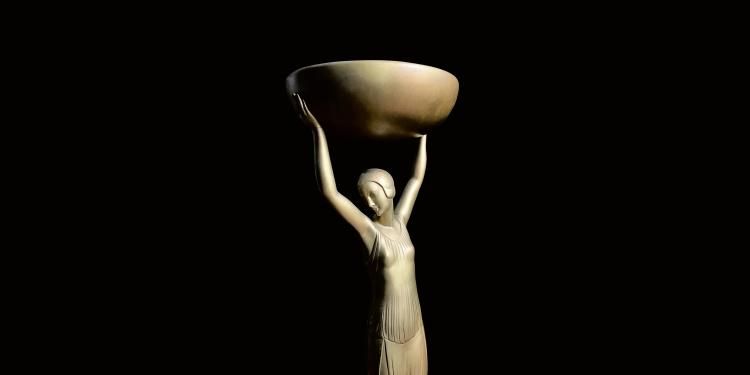
Opinion
Book recommendations

Best known as the creator of such children’s classics as Meg and Mog and Haunted House, the artist Jan Pieńkowski also designed the original Booker Prize trophy, which has returned in his honour
She stands tall and elegant, wearing a pleated sleeveless gown. Her head is turned to the right, her hair set in a tight bob. Her arms stretch above her, holding a large bowl. She doesn’t have a name, but you might still recognise her as the original Booker Prize trophy.
Unveiled at the first prize ceremony in 1969, the statuette was awarded to P.H. Newby for his 17th novel, Something to Answer For. As tall as the FA Cup, its shape resembled an Olympic torch – especially in BBC footage from that first year, which featured flames flickering in the trophy’s bowl.
It had been designed by the artist Jan Pieńkowski, who was then at the start of a career that would see him go on to create and illustrate the award-winning Meg and Mog children’s books. Born in Warsaw in 1936, Pieńkowski was three years old when the Nazis invaded Poland. His family were forced to live underground before fleeing across Europe, settling in England in 1946.
Pieńkowski spoke no English until he was 10 years old, yet quickly caught up. He read English and Classics at King’s College, Cambridge, before founding Gallery Five, a company that initially designed greetings cards. In his spare time, he illustrated children’s books for Jonathan Cape, whose publisher, Tom Maschler, was instrumental in founding the Booker Prize. In 1968, Maschler called Pieńkowski to say, ‘Jan, you’re a designer, could you design me a trophy for this new prize that’s being set up?’
The original Booker Prize trophy awarded to the first winner, P.H. Newby in 1969. The trophy was designed by Jan Pieńkowski, better known as the creator of the Meg & Mog children’s book series.
Pieńkowski’s medium was paper and he admitted that he didn’t have the first idea about trophies. His brief was, it seems, wide open. Photographs stored at the de Grummond Children’s Literature Collection at the University of Southern Mississippi, which holds a number of Pieńkowski’s papers, show what appear to be several rejected designs for the trophy, including an egg, a seated woman with a book on her lap and a phallus. Pieńkowski settled on his final design, so the story goes, after stumbling upon an old art deco lamp in London’s Portobello Market - it provided the inspiration he needed.
In March 1969, the Booker Prize ordered eight trophies featuring the standing woman, at a cost of £52 10s each (roughly £750 today), with an extra £10 to be added later for an aluminium finish. A hundred cheap replicas were also ordered, to be displayed in bookshops.
Each silver-coloured trophy stood twenty-four and a half inches tall, measuring eight inches in width at the bowl. They were arguably too big to be displayed on the winner’s mantelpiece, but the large bowl came in handy.
P.H. Newby’s daughter, Sarah, remembered both the real trophy and one of the replicas being on display in the family home; one in the bathroom and one in the hall, both with plants sitting on top of them. She recalled: ‘Some time later, my mother spray-painted both trophies gold. She thought it would look better. My father wasn’t bothered.’ After the Newbys moved house, one of the trophies was placed near the front door ‘and used to put keys in’.
Jan Pieńkowski
© Harry Todd/Fox Photos/GettyIn 1973, a compact, ten-inch version of the trophy was created by artist Patricia Turner and this smaller statuette was handed out to Booker Prize winners for several years, until authors began to be presented with a leather-bound copy of their book instead. By that point, Pieńkowski was well into his successful career in children’s books. In 1971, he won the first of his two Kate Greenaway Medals, for The Kingdom Under the Sea and Other Stories. The first of over 20 Meg and Mog books, illustrated by Pieńkowski and written by Helen Nicholl, had been published the previous year. He died in February this year, aged 85, having earned a reputation as one of the all-time great children’s book illustrators.
For 2022, Pieńkowski’s Booker design has been revived in his honour. Newby’s original trophy has been scanned and 3D-printed by Adam Lowe’s Madrid-based Factum Foundation, a not-for-profit that uses cutting-edge technology to create facsimiles of important and imperilled cultural artefacts around the world, including a recreation of Tutankhamun’s tomb in Egypt. She will be 38cm high, cast in pewter and painted gold - the colour is now part of Booker folklore, thanks to P.H. Newby’s wife.
Now all she needs is a name.
Jan Pieńkowski’s legacy includes much-loved children’s books and the Booker Prize trophy.
© Turned Out Nice / Alamy

